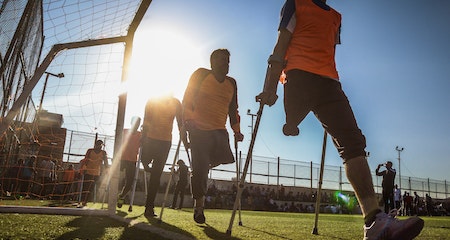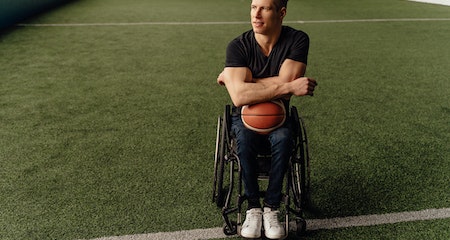There are numerous benefits to physical activity, especially for people who have disabilities. It improves their mental health and helps them feel better about themselves.
Many people with disabilities are not getting the recommended amount of exercise, despite this. This article provides a brief overview of the ways that health professionals can help people living with disabilities to get active.
Aerobics
Aerobics is any physical exercise that increases your heart rate and breathing to supply more oxygen to your muscles. It is a great way to stay healthy and reduce the chances of developing diseases such as heart disease, stroke and diabetes, as well as obesity.
Aerobic exercise stimulates the heart and lungs to circulate more oxygen-rich blood throughout the body. It also improves the endurance of muscle. It also increases circulation, which can help with reducing elevated cholesterol and blood pressure.
. You should begin with activities that are low-intensity and gradually increase your workout to high intensity exercise as your fitness level increases.
Consult your physician prior to you begin your aerobics. This will help avoid unnecessary risks like overexertion, and ensure that you can safely do your exercises.
A personal trainer can teach you the basics of weight training and aerobics even if you’re not an experienced or skilled fitness instructor. A qualified instructor can help you choose the best exercise and equipment to meet your requirements.
Getting enough aerobic activity is key to staying healthy, according to the HHS. The HHS recommends 150 minutes of moderate intensity or 75 minutes of vigorous-intensity aerobic exercises per week. The Guidelines encourage participants to engage in muscle-building activities every day of the week, including adapted yoga or working with resistance bands.
The CDC affirms that physical exercise helps prevent or treat chronic conditions, such as heart disease, obesity, diabetes, stroke, and some cancers. It can boost your mood and reduce stress.
Exercise is an important aspect of a person’s health and well-being, especially for those with disabilities. It can aid them in maintaining their independence and improve the living quality, the CDC states.
In addition to physical health benefits, those with disabilities can improve their mental health by taking part in aerobics and other types of exercise. It can offer social support and community. A group fitness class, for example can help people with disabilities feel more connected to others.
. This is particularly relevant for those who suffer from an impairment that restricts your strength or range. You may also benefit from this activity in the event that you suffer from an illness that causes pain, such as multiple sclerosis or arthritis.
relaxes muscles and relieve tension. This is especially beneficial for those suffering from spasticity due to cerebral palsy, or other conditions. It can also help your flexibility by extending your range of motion.
Apart from the benefits swimming brings to the body it is also a great way to build self-confidence. It can also help you develop a lifesaving skill which can be extremely valuable in emergency situations.
is beneficial for all, but it’s especially important for children with disabilities. It helps them develop coordination, balance, and other gross motor skills.
, as with any aerobic exercise can reduce your chance of developing cardiovascular disease and diabetes.
Before beginning any kind of exercise program, check with your doctor if you have disabilities. This will ensure that you don’t put undue stress on your body or cause other health problems.

When you exercise, your body releases endorphins and serotonin. Both are essential hormones that can boost your mood. They can also aid you in sleeping better and lower stress levels. They can also improve your memory function, which can boost your energy levels throughout the day.
- Weight Training
Training with weights is a popular activity that allows people to increase their muscle mass and increase their fitness. It’s a good choice for people with disabilities since it can help to improve bone density and endurance.
It’s also beneficial to those who are recovering from an injury or surgery. It can improve balance and reduce the risk of falling. It can strengthen bones, muscles and tendons to help prevent future injuries.
Your doctor or physical therapist can assist you safely and effectively complete exercises for strength. They can recommend safe ways to utilize resistance bands or free weights, as well as exercise machines. They can also help you learn proper technique and form to avoid injuries while exercising.
You can, for example using the wheel or chair to support your arms while you do biceps curls and shoulder presses. You can also wrap an object around your muscles and secure it with fabric closures to help you get stronger.
Weight training will not only strengthen your muscles, but also boost your cardiovascular capacity. It can also boost your endurance and help you deal with stress.disability services melbourne
Getting enough aerobic activity can also reduce the risks of developing chronic health problems like heart disease, obesity and stroke. CDC guidelines suggest that adults should be getting at least 150 minutes a week of moderate intensity aerobic exercise or 75 minutes a week of vigorous-intensity aerobic activity or a similar combination of both.
Adults with disabilities should do two to three sessions every week of high-intensity moderate-intensity strength-training activities. This includes all major muscle groups. ner is available to help you achieve your weight goals and instruct the techniques for weight training.
Chair Pushups
Chair pushups can be a great exercise for people who are unable to perform standard pushups because of health, disability, or weight problems. This easy exercise can help strengthen the chest, triceps muscles and the shoulder’s front.
They then tilt their upper body forward slightly and attempt to lift themselves until they stand fully.
Then, they can return to a seated in a seated position and complete three sets of 10 repetitions.
Slide one hand out to the side and lower your body, then bring it back in while you push up. They can also make use of a towel or slider to help reduce the burden off of the pushing arm.
Anyone can use these exercises to build up their strength. They can be especially beneficial to those recovering from surgery or a disability or injury, and may also help people with chronic conditions such as arthritis to keep active and healthy.
These exercises can aid in preventing injuries and falls by strengthening your upper body. In addition, they can boost your mood and improve your overall outlook on life.
This exercise is a great supplement to any physical routine.



